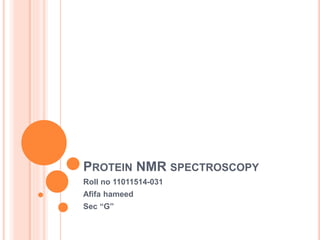
NMR of protein
- 1. PROTEIN NMR SPECTROSCOPY Roll no 11011514-031 Afifa hameed Sec “G”
- 2. INTRODUCTION most commonly known as NMR spectroscopy, is a research technique that exploits the magnetic properties of certain atomic nuclei. It determines the physical and chemical properties of atoms or the molecules in which they are contained. It relies on the phenomenon of nuclear magnetic resonance and can provide detailed information about the structure, dynamics, reaction state, and chemical environment of molecules. A spectroscopic technique that gives us information about the number and types of atoms in a molecule. Nuclear magnetic resonance spectroscopy is a powerful analytical technique used to characterize organic molecules by identifying carbon-hydrogen frameworks within molecules.
- 3. Nuclear Magnetic Resonance In the Nucleus
- 4. Most frequently, NMR spectroscopy is used by chemists and biochemists to investigate the properties of organic molecules. history experimentally observed in late 1945 simultaneously by the research groups of Felix Bloch, at Stanford University and Edward Purcell at Harvard University. Bloch and Purcell were jointly awarded the Nobel Prize in Physics in 1952 for their discovery of Nuclear Magnetic Resonance.
- 6. COMPONENTS. A magnet Sample and sample holder Radiofrequency generator Detector Recorder
- 7. Types Two common types of NMR spectroscopy are used to characterize organic structure. 1) 1H NMR: is used to determine the type and number of H atoms in a molecule. 2) 13C NMR is used to determine the type of carbon atoms in the molecule.
- 8. PROCEDURE The sample is dissolved in a solvent (CCl4, CDCl3 ) The sample is in a small cylindrical glass tube b/w two poles of magnet. sample is spun around the axis . Between gaps of poles a coil that attach Rf generator that provide electromagnetic energy and change spin orientation. Perpendicular to the RF oscillator coil is a detector coil. When sample absorbs energy, however, the reorientation of the nuclear spins induces a radiofrequency signal in the plane of the detector coil. the typical NMR spectrometer uses a constant frequency RF- signal and varies the magnetic field strength. magnetic field strength is increased, the processional frequency of all the protons increase. As the field strength is increased linearly, a pen travels across a recording chart.
- 10. APPLICATIONS In chemistry: study chemical bonds. two dimensional approaches used to study complex molecules. used to study chemical bonds. In medical I n BRAIN Distinguishing gray matter & white matter and detect tumors. In ABDOMEN Metabolic liver disease detect by NMR. Measures liver iron over load in hemochrtosisoma In KIDNEYS Distinguishing renal cortex & medulla To evaluate transplanted kidney. In HEART Tomographic images of heart muscle, chambers, valvular structures. In BREAST 3D-NMR & single-slice planar imaging in detecting breast abnormalities. In MUSCULO SKELETAL SYSTEM Demonstrates Osteomyelitis, tumor metastasis in vertebral bodies & pelvic bones. Provide Images of muscles, tendons, ligaments
- 11. NMR IN PHARMACEUTICAL RESEARCH Leading technology for 3-D structure determination of bio- macromolecules Studying protein structure SAR by NMR – Novel lead compounds Chemical shift mapping – Structural information on the binding modes and site positions Molecular dynamics, conformational analysis Benefits Eliminates risk of x-radiation Excellent spatial & contrast resolution Detecting diseases at earlier stages